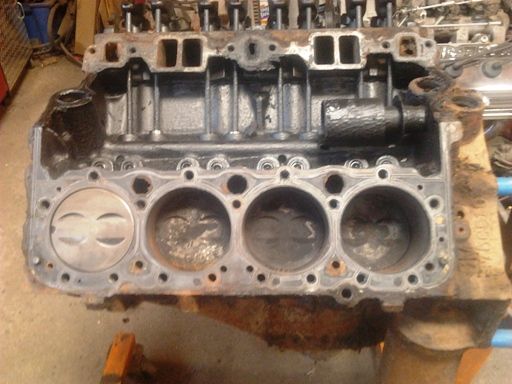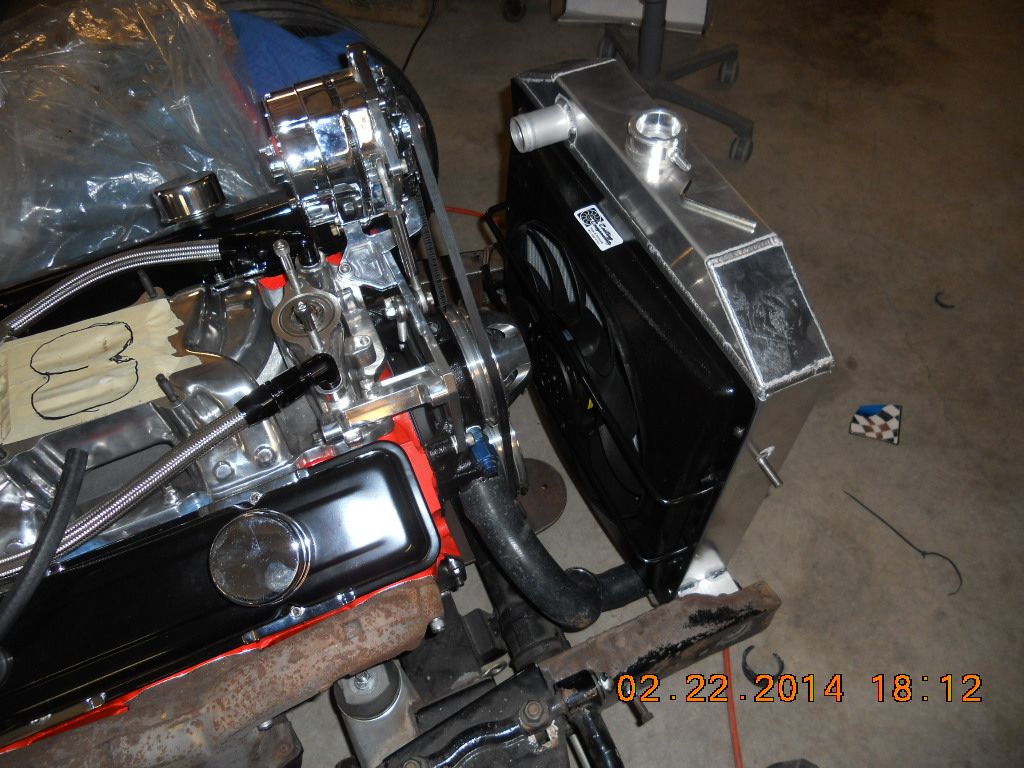Thread: 1940 Ford Pickup
Hybrid View
-
02-11-2014 06:28 AM #1
That's why it's critical to use the spring loaded bottom bolts, so that the flex of the frame compresses the springs as opposed to torquing the radiator. At least on mine, the top braces also provide enough flex that I'm not concerned with twisting the radiator tank. Of course I may be wrong, but I'm not worrying about it.Roger
Enjoy the little things in life, and you may look back one day and realize that they were really the BIG things.
-
02-11-2014 03:25 PM #2
I worry about everything ! Some times I just have to get over it. I went to install my donor flexplate on my engine 2 day and as usual with my free parts it was wrong, too big. So here's the question. I have 2 choices for a new flexplate, standard for $30. or Heavy Duty for $90. It seems like it'd be a big pain to have to pull the motor for a bad plate in a few years. I guess what I'm asking have you guys had any troubles with the standard plates ? Thanks
-
02-11-2014 03:34 PM #3
Why is it too big???? There were some different diameters /number of teeth---but all it took was using the correct starter location-----
-
02-11-2014 08:12 PM #4
-
02-11-2014 08:43 PM #5
Roger
Enjoy the little things in life, and you may look back one day and realize that they were really the BIG things.
-
02-12-2014 01:48 AM #6
Like the other have mentioned the I’m not sure what you mean by being too big…….The flex plate won’t fit in the bellhousing or the starter interferes.
To expand a bit on what Roger posted.
If it’s the case of the starter interfering, there are different starters used for the 168 and 153 tooth flex plates. The one for the 168 tooth flex plate uses a starter that has the mounting bolts staggered, and the starter for the 153 tooth flex plate has starter bolts located straight across from each other.
Just a bit of FYI…..the 1958-1962 283 blocks came with a 168 tooth flywheel (the flex plate you currently have) and the block is drilled for the staggered bolt starter. They do not have the second bolt hole drilled for the 153 tooth straight bolt starter. The second bolt hole can be drilled and tapped in the block if you need it however.
As far as needing the HD flex plate, I would say probably not as long as the one you have is in good condition. My experience is that flex plates normally go bad in the teeth area due to improperly adjusted starters. I have replaced a few over the years that were cracked out in the center area where they bolt to the crank flange, but that is fairly rare. With a 283 I wouldn’t worry too much about ripping the center out.
.Last edited by Mike P; 02-12-2014 at 01:56 AM.
I've NEVER seen a car come from the factory that couldn't be improved..... 
-
02-12-2014 05:03 PM #7
Thanks for the inputs guys ! Here's what I did. I put a new flywheel on the motor to match the starter I had, it was cost effective. The block does have 3 holes for starter mounting . The way I see it the starter should be able to turn over a 283 even with the smaller flywheel.
Here's today question, its about venting the crank case.
I have the vent cap that is bolted to the back top side of the block, {see pic with no cap installed}. I have a vent cap in each valve cover.
Do I need to keep the block vent or can I block it off with some nice turned aluminum plug . ?? OR should I run the hose that originally came off the block vent to the carb where a PVC valve would hook up ? And what about a PCV valve ?
Here's some pic's.

engine starter combo

-
02-12-2014 05:17 PM #8
If you're using this on the street primarily, then I'd vote yes to the PCV Valve on one side and a Breather Cap in the opposite valve cover, then plug the intake with a welch cap. I like breathing clean air thank you very much! LOL..
If you're heading for the track primarily, then use the vented intake as well as vent the valve covers. And yes, you've labeled the hose connections right on the Holley. There should be 1 more under the front bowl also. Is yours plugged?
-
02-12-2014 05:24 PM #9
Maybe this'll help too?
-
02-12-2014 05:43 PM #10
You will definitely want to run a PVC valve. There are a couple of options, but if it were me I would do as 34_40 suggests and run the valve in one valve cover and the a breather cap on the other, then tap a freeze plug in the vent hole.
If you elect to run the PVC valve from the vent hole in the block you need to verify that the vapor separator (the round can looking thing in the lifter valley) is in place or you will suck oil into the intake. Normally you only need to run the PVC valve in the back of the block if you are running the early non-vented valve covers and have the fill tube/breather on the intake..

.I've NEVER seen a car come from the factory that couldn't be improved..... 
-
02-12-2014 06:11 PM #11
Positive Crankcase Vent
Poly Vinyl Cloride
And the vent on the side of the metering plate is used on Ford applications----the GM type use the bottom one
why are you running coolant hoses off the back of the manifold??
-
02-12-2014 07:36 PM #12
30-40, Mike P and Jerry thanks for your reply's. PCV valve it will be.
Jerry: The reason I have the coolant hoses in the manifold is that the whole manifold set up was a gift from a close friend. Its supposed to aid in cooling the engine more evenly. If had to buy a manifold it'd be just a plain jane but I like gifts !
-
02-22-2014 05:16 PM #13
-
02-23-2014 03:36 PM #14
-
02-23-2014 03:42 PM #15
I used Taylor's that had the plug boot fixed, distributor end cut-to-length. Mine were plenty long, and my routing was very similar to yours but dropped down below the headers with the group, and of course they went toward the correct end of the motor instead of being buried in the back....




Roger
Enjoy the little things in life, and you may look back one day and realize that they were really the BIG things.





 815Likes
815Likes

 LinkBack URL
LinkBack URL About LinkBacks
About LinkBacks Reply With Quote
Reply With Quote





Ditto on the model kits! My best were lost when the Hobby Shop burned under suspicious circumstances....
How did you get hooked on cars?